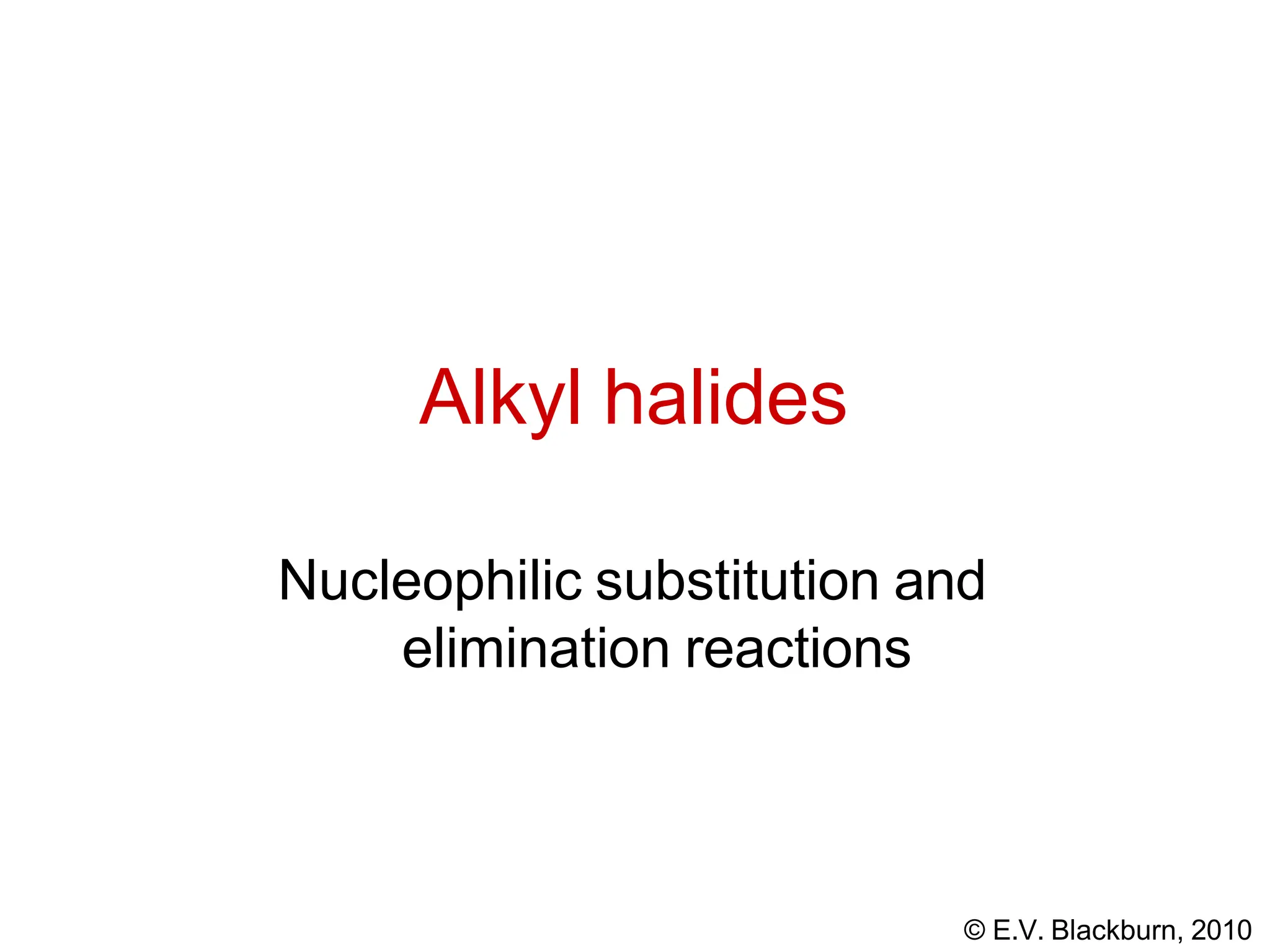The document discusses alkyl halides and their reactions. It describes how alkyl halides are produced industrially and from alcohols. It also discusses nucleophilic substitution and elimination reactions of alkyl halides. The key reactions discussed are the SN2 and SN1 mechanisms, and how factors like solvent polarity, leaving group ability, and sterics affect whether SN2 or SN1 occurs.












![Nucleophilic substitution
rate [CH3Br][OH-]
rate = k[CH3Br][OH-]
CH3Br + CH3OH + Br-
© E.V. Blackburn, 2010
OH-
[CH3Br]I
0.001 M
[OH-]I
1.0 M
initial rate
3 x 10-7 molL-1s-1
0.002 M 1.0 M 6 x 10-7 molL-1s-1
0.002 M 2.0 M 1.2 x 10-6 molL-1s-1](https://image.slidesharecdn.com/alkylhalides-240411035604-4533a81b/75/alkylgghhhhhhhyyggghyyyyyuuu_halides-pptx-13-2048.jpg)
![© E.V. Blackburn, 2010
Order - a summary
The order of a reaction is equal to the sum of the
exponents in the rate equation.
Thus for the rate equation rate = k[A]m[B]n, the overall
order is m + n.
The order with respect to A is m and the order with
respect to B is n.](https://image.slidesharecdn.com/alkylhalides-240411035604-4533a81b/75/alkylgghhhhhhhyyggghyyyyyuuu_halides-pptx-14-2048.jpg)
![Nucleophilic substitution
Br
© E.V. Blackburn, 2010
CH3
CH3-C-CH3
OH
CH3
CH3-C-CH3 + OH-
+ Br-
rate [(CH3)3CBr][OH-]0
rate = k[(CH3)3CBr]
[(CH3)3CBr]I
0.001 M
[OH-]I
1.0 M
initial rate
4 x 10-7 molL-1s-1
0.002 M 1.0 M 8 x 10-7 molL-1s-1
0.002 M 2.0 M 8 x 10-7 molL-1s-1](https://image.slidesharecdn.com/alkylhalides-240411035604-4533a81b/75/alkylgghhhhhhhyyggghyyyyyuuu_halides-pptx-15-2048.jpg)
![+ Br-
References of interest:
E.D. Hughes, C.K. Ingold, and C.S. Patel, J. Chem. Soc., 526 (1933)
J.L. Gleave, E.D. Hughes and C.K. Ingold, J. Chem. Soc., 236 (1935)
CH3Br + CH3OH + Br-
OH-
rate = k[CH3Br][OH-]
The SN2 mechanism
OH- Br HO
-
HO
© E.V. Blackburn, 2010
-
Br](https://image.slidesharecdn.com/alkylhalides-240411035604-4533a81b/75/alkylgghhhhhhhyyggghyyyyyuuu_halides-pptx-16-2048.jpg)
![Stereochemistry of the SN2
reaction
OH- Br
-
HO
-
Br
Br
C6H13
H
H3C
(-)-2-bromooctane
[] = -34.6o
OH
C6H13
H
H3C
(-)-2-octanol
[] = -9.9o
(+)-2-octanol
[] = +9.9o
© E.V. Blackburn, 2010
HO
HO
+ Br-
C6H13
H
CH3](https://image.slidesharecdn.com/alkylhalides-240411035604-4533a81b/75/alkylgghhhhhhhyyggghyyyyyuuu_halides-pptx-17-2048.jpg)
![A Walden inversion.
P. Walden, Uber die vermeintliche optische Activät der
Chlorumarsäure und über optisch active Halogen-
bernsteinsäre, Ber., 26, 210 (1893)
Stereochemistry of the SN2
reaction
Br
© E.V. Blackburn, 2010
C6H13
H
H3C
HO
C6H13
H
CH3
(-)-2-bromooctane
[] = -34.6o
(+)-2-octanol
[] = +9.9o
optical purity = 100%
NaOH
N
S 2](https://image.slidesharecdn.com/alkylhalides-240411035604-4533a81b/75/alkylgghhhhhhhyyggghyyyyyuuu_halides-pptx-18-2048.jpg)
![The SN1 mechanism
rate = k[(CH3)3CBr]
Br
CH3
CH3-C-CH3 + OH-
CH3
CH3-C-CH3
OH
+ Br-
CH3
1. H3C C CH3
Br
CH3
+
H3C C CH3 + Br-
2.
© E.V. Blackburn, 2010
CH3
+
H3C C CH3 + OH-
CH3
H3C C CH3
OH
slow
fast](https://image.slidesharecdn.com/alkylhalides-240411035604-4533a81b/75/alkylgghhhhhhhyyggghyyyyyuuu_halides-pptx-19-2048.jpg)


![Stereochemical consequences of
a carbocation
CH3
1. H3C C CH3
Br
CH3
H3C C CH3
+
+ Br-
slow
OH-
© E.V. Blackburn, 2010
H O
2
SN1
Br
C6H13
H
H3C
(-)-2-bromooctane
[] = -34.6o
?](https://image.slidesharecdn.com/alkylhalides-240411035604-4533a81b/75/alkylgghhhhhhhyyggghyyyyyuuu_halides-pptx-22-2048.jpg)
![Stereochemical consequences of
a carbocation
CH3
H3C C CH3
+
+ Br-
slow
6 13
© E.V. Blackburn, 2010
(+)-C H CHOHCH3
OH-
H O
2
SN1
reduced optical
purity
Br
CH3
1. H3C C CH3
Br
C6H13
H
H3C
(-)-2-bromooctane
[] = -34.6o
Why?](https://image.slidesharecdn.com/alkylhalides-240411035604-4533a81b/75/alkylgghhhhhhhyyggghyyyyyuuu_halides-pptx-23-2048.jpg)
























